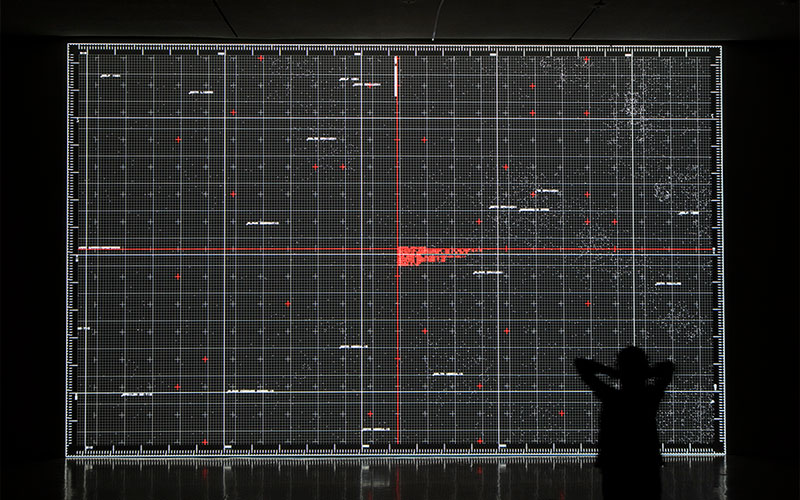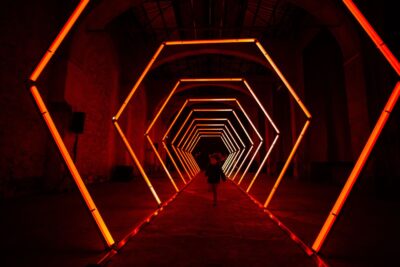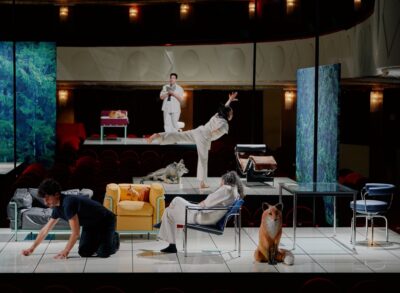2006 >>
datamatics is an art project that explores the potential to perceive the invisible multi-substance of data that permeates our world. It is a series of experiments in various forms – audiovisual concerts, installations, publications and CD releases – that seek to materialise pure data.
datamatics [prototype-ver.2.0]

Using pure data as a source for sound and visuals, datamatics combines abstract and mimetic presentations of matter, time and space in a powerful and breathtakingly accomplished work. datamatics is the second audiovisual concert in Ryoji Ikeda’s datamatics series, an art project that explores the potential to perceive the invisible multi-substance of data that permeates our world. Projecting dynamic, computer-generated imagery – in pared down black and white with striking colour accents, Ikeda’s intense yet minimal graphic renderings of data progress through multiple dimensions. From 2D sequences of patterns derived from hard drive errors and studies of software code, the imagery transforms into dramatic, rotating views of the universe in 3D, whilst the final scenes add a further dimension as four-dimensional mathematical processing opens up spectacular and seemingly infinite vistas. A powerful and hypnotic soundtrack reflects the imagery through a meticulous layering of sonic components to produce immense and apparently boundless acoustic spaces. datamatics, alongside the recently released and critically acclaimed dataplex album, marks a significant and exciting progression in Ikeda’s work.
datamatics [ver 2.0] is the new, full–length version of Ryoji Ikeda’s acclaimed audiovisual concert. For datamatics [ver.2.0], Ikeda has significantly developed the earlier version of this piece (premiered in March 2006), adding a newly commissioned second part. Driven by the primary principles of datamatics, but objectively deconstructing its original elements – sound, visuals and even source codes – this new work creates a kind of meta–datamatics. Ikeda employs real–time programme computations and data scanning to create an extended new sequence that is a further abstraction of the original work. The technical dynamics of the piece, such as its extremely fast frame rates and variable bit depths, continue to challenge and explore the thresholds of our perceptions.
| credits | directed by Ryoji Ikeda concept, composition: Ryoji Ikeda [prototype-ver.1.0] [ver.2.0] co-produced by les Spectacles vivants–Centre Pompidou, YCAM, 2008 |




| materials | 7 DLP projectors, computers, speakers | ||
| dimensions | dimensions variable (suggested: W2.5 x H3.5 x D22m) | ||
| date | place |
|
||
| credits | concept, composition: Ryoji Ikeda computer graphics, programming: Tomonaga Tokuyama |

| materials | DLP projector, computer, speakers | ||
| dimensions | W18 x H13.5m (video projection throw distance: D30m) | ||
| date | place |
|
||
| credits | concept, composition: Ryoji Ikeda computer graphics, programming: Shohei Matsukawa, Tomonaga Tokuyama |
| materials | DLP projector, computer, speakers | ||
| dimensions | dimensions variable | ||
| date | place |
|
||
| credits | concept, composition: Ryoji Ikeda computer graphics, programming: Shohei Matsukawa, Tomonaga Tokuyama |



data.tron [8K enhanced version] is part of the datamatics project. The new work is an enhanced version of the audiovisual installation data.tron, where each single pixel of visual image is strictly calculated by mathematical principle, composed from a combination of pure mathematics and the vast sea of data present in the world. In this latest version visitors are literally immersed in the work, as data is seamlessly projected onto the gallery wall and floor from eight sources.
| materials | 8 DLP projectors, computers, 9.2ch sound system | ||
| dimensions | W16 x H9 x D9m | ||
| date | place |
|
||
| credits | concept, composition: Ryoji Ikeda computer graphics, programming: Tomonaga Tokuyama commissioned by Ars Electronica, 2008-09 |

| materials | 3 DLP projectors, computers, speakers | ||||||||
| dimensions | dimensions variable (suggested: W24 x H6 xD12m) | ||||||||
| date | place |
|
||||||||
| credits | concept, composition: Ryoji Ikeda computer graphics, programming: Shohei Matsukawa, Tomonaga Tokuyama |

| materials | DLP projector, computer, speakers | ||
| dimensions | dimensions variable | ||
| date | place |
|
||
| credits | concept, composition: Ryoji Ikeda computer graphics, programming: Shohei Matsukawa, Tomonaga Tokuyama |


How many points are there in a line?
What is the number of numbers?
How can we verify that the random is random?
data.tron is part of the datamatics project, which is a series of experiments that explore such questions, physically and mathematically. Visitors will experience the vast universe of data in the infinite between 0 and 1.
data.tron is an audiovisual installation, where each single pixel of visual image is strictly calculated by mathematical principle, composed from a combination of pure mathematics and the vast sea of data present in the world. These images are projected onto a large screen, heightening and intensifying the viewer’s perception and total immersion within the work.
| materials | DLP projector, computer, speakers | ||||||||||||||||||||||||
| dimensions | dimensions variable (suggested: W8 x 6m) | ||||||||||||||||||||||||
| date | place |
|
||||||||||||||||||||||||
| credits | concept, composition: Ryoji Ikeda computer graphics, programming: Shohei Matsukawa co-produced by Le Fresnoy Studio National des Arts Contemporains and Forma, 2007 |


| materials | 5 DLP projectors, computers, speakers | ||
| dimensions | dimensions variable (suggested: W7 x H9 x D30m) | ||
| date | place |
|
||
| caption | concept, composition: Ryoji Ikeda computer re-programming: Tomonaga Tokuyama original computer programming: Shohei Matsukawa, Norimichi Hirakawa, Tomonaga Tokuyama |


| materials | 10 DLP projectors, computers, speakers, wooden plinths | ||||||||||||||||||||
| dimensions | dimensions variable (suggested: W27 x H6 xD8m) | ||||||||||||||||||||
| date | place |
|
||||||||||||||||||||
| credits | concept, composition: Ryoji ikeda computer graphics, programming: Shohei Matsukawa, Norimichi Hirakawa, Tomonaga Tokuyama |


| materials | LED 27inch displays, computers, speakers, wooden panels | ||||||||||||||||||
| dimensions | W40 x H70 x D65cm (each) | ||||||||||||||||||
| date | place |
|
||||||||||||||||||
| credits | concept, composition: Ryoji Ikeda computer graphics, programming: Norimichi Hirakawa, Tomonaga Tokuyama |
||||||||||||||||||

data.scan is an audiovisual installation composed from a combination of pure mathematics and the vast sea of data present in the world. Each single pixel of the visual image is strictly calculated by mathematical principle. Visitors to the exhibition will experience the vast universe of data in the infinite between 0 and 1.
data.scan presents an audio-visual relationship relating to large sets of data from two recent meta-scientific investigations that have mapped the human body and the astronomical universe. The horizontal monitor-based data.scan is registered intimately in relation to the viewer’s body. The dialogue of sound and image in data.scan addresses notions of randomness, extremities of scale, and binaries of the visible/audible and invisible/inaudible.
| materials | LED 24inch display, computer, speaker, wooden panels | ||||||||||||||||
| dimensions | W384 x H700 x D573mm | ||||||||||||||||
| date | place |
|
||||||||||||||||
| credits | concept, composition: Ryoji Ikeda computer graphics, programming: Shohei Matsukawa, Norimichi Hirakawa, Tomonaga Tokuyama |

| materials | 35mm microfilm, LED bulbs, wooden panels, acrylic panels | ||
| dimensions | W8052 × H700 × D175mm | ||
| date | place |
|

| materials | 35mm microfilm, LED bulbs, wooden panels, acrylic panels | ||
| dimensions | W8052 × H700 × D175mm | ||
| date | place |
|


How many points are there in a line?
What is the number of numbers?
How can we verify that the random is random?
data.film is part of the datamatics project, which is a series of experiments that explore such questions, physically and mathematically. Visitors will experience the vast universe of data in the infinite between 0 and 1.
A sculptural wall installation, data.film consists of a series of 35mm film mounted in a light box. The image on the film is constructed from microscopically printed data codes and patterns from pure digital sources, while the unusual proportions of the light box (4 cm high, 10 metres wide, 4 cm deep) create a long, narrow strip of film. Only upon close examination by the viewer can the film and its contents be recognised.
| materials | 35mm film, LEDs, aluminum panels, acrylic panels | ||||||
| dimensions | W1000 x H4 x D5cm | ||||||
| date | place |
|
||||||
| credits | concept, composition: Ryoji ikeda computer graphics and LED light box design: Shohei Matsukawa 35mm film development and print: Color by Dejonghe n.v. (Kortrijk, Belgium) co-produced by Le Fresnoy Studio National des Arts Contemporains and Forma, 2007 |

| materials | 35mm film, LED lamps, acrylic panels, wooden panels | ||
| dimensions | W180 x H70 x D12cm | ||
| date | place |
|


data.spectra is the first work of the data.series. Across the entire width of a darkened room is an intensely bright, narrow screen. On moving closer, the screen reveals that the source of the flood of light into the room is a vast array of tiny digits streaming across the surface, seemingly without end.
| materials | 10 DLP projectors, computers, speakers, acrylic panels, wooden walls | ||
| dimensions | W10 x H4 x D10m (screen size: W10000 x H25mm) | ||
| date | place |
|
||
| credits | concept, composition: Ryoji Ikeda computer graphics, technical realization: Shohei Matsukawa technical director: Kamal Ackarie technical assistance: Tomonaga Tokuyama commissioned by The Australian Centre for the Moving Image (ACMI), 2005 produced by Forma |

| materials | 8 speakers, computer | ||
| dimensions | dimensions variable | ||
| date | place |
|
developing and researching alongside the radio program series, this [multi-channel concert] demonstrates the results of the investigation about the fundamental concept of digital, the data of sound, the sound of data. it is performed in a pitch-dark space as a multi-channel concert with a matrixed setup of specific loudspeakers, which forms a unique spatiotemporal sound field to listeners. the experience is straight-ahead physical, and is a series of experiments to test one’s potential how (much) he/she can perceive and decipher the infinite numbers of data-codes in the blind state.

text: Kazunao Abe, Maria Belen Saez de Ibarra, Benjamin Weil
format: 18,2 × 25,7 cm
pages: 144
binding: hardback
illustrations: 48 in color
year: 2012
edition: English/spanish
price: €39.00/$47.50
printed in Italy
ISBN 978-88-8158-834-3
| date | place |
|

dataphonics [2006-07] is a music project by ryoji ikeda, which focuses on the relationship between the sound of data and the data of sound. It spans various formats – multi-channel sound performance, radio broadcasts and audio/data research. dataphonics [radio series] was commissioned by L’Atelier de Création Radiophonique (ACR) de France Culture. It consists of ten six-minute segments, first broadcast monthly on Radio France during 2006-07. Various non-audio data were converted forcefully to audio data, which became the materials from which the tracks were composed. Moreover, this book examines the visualization of the composed tracks through the ultimate binary reduction of sound waveforms. dataphonics forms part of datamatics, an ongoing project by ryoji ikeda since 2006, in which he explores the potential to perceive the invisible multi-substance of data that permeates our world through audiovisual concerts, installations, cds and publications.
| date | place |
|
||||||||||
| credits |
programming & design: Tomonaga Tokuyama |


dataplex is the much-anticipated new release from leading Japanese electronic composer Ryoji Ikeda. Since the mid 1990s, Ikeda has pioneered a radical and highly influential minimalist approach in the worlds of electronic and contemporary music. His seventh solo album and the first musical composition in the datamatics series – a new body of work across various media that uses data as both its material and its theme – dataplex presents a significant and stunning progression in Ikeda’s career.
Aside from demonstrating Ikeda’s unrivalled standards of technical precision, minute sound construction and engineering, the album also introduces an extraordinary and fascinating overall structure.
The first eight tracks of dataplex consist mostly of high-frequency raw data. Their structures are located clearly outside the cosmos of music. Instead, these linear tracks seem to be source code transformed into an audible medium; a constant stream of data, they represent the basic material of the album.
The following pieces become longer, increasingly complex and distinctly inter-related, before the rhythmic structure itself metamorphoses. Rhythms and tones are refracted progressively, until, with track 18, data.vortex, Ikeda opens up an apparently infinite acoustic space with an expansive piece that contrasts dramatically with all that precedes it.
And following this caesura the album almost ends in the way it started , sinking back into the data flow.
Through meticulous attention to detail and the most minimal of gestures, Ikeda succeeds in expanding and enhancing his sound design to reveal a new universe to the listener. dataplex opens up avenues of pure musical abstraction whilst simultaneously embracing complex, unique and elegant individual composition.
In its entirety, dataplex remains inscrutable; a mystery whose secrets require individual investigation and discovery. Its defiance of appropriate definition, description or comparison, ultimately underpins the pioneering nature of this long-awaited release.
| date | place |
|
||||||||||||||||||||||||||||||||||||||||||||||||||||||||||||||||||||||||
| spec |
|
||||||||||||||||||||||||||||||||||||||||||||||||||||||||||||||||||||||||
| credits | produced by Ryoji Ikeda © 2005 Ryoji Ikeda (JASRAC) |





